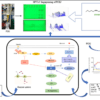Joha rice, aromatic rice cultivated in the Northeastern region of India is effective in lowering the blood glucose and preventing diabetes onset and hence is an effective nutraceutical of choice in diabetes management.
Joha is a short-grain winter paddy known for its significant aroma and noteworthy taste. The traditional claims are that the consumers of Joha rice have low incidence of diabetes and cardiovascular diseases, but these needed scientific validation.
Towards that direction, scientists at the Institute of Advanced Study in Science and Technology (IASST), an autonomous institute of the Department of Science and Technology explored the nutraceutical properties of aromatic Joha rice. Rajlakshmi Devi along with Paramita Choudhury in their research explored the nutraceutical properties of aromatic Joha rice. Through in vitro laboratory analysis, they detected two unsaturated fatty acids viz., linoleic acid (omega-6) and linolenic (omega-3) acid. These essential fatty acids (which human cannot produce) can help maintain various physiological conditions. Omega-3 fatty acid prevents several metabolic diseases such as diabetes, cardiovascular diseases, and cancer. Joha has also proved to be effective in lowering the blood glucose and preventing diabetes onset in diabetic rats.
The researchers also found that scented Joha rice has a more balanced ratio of omega-6 to omega-3 in comparison to the widely consumed non-scented variety. The ratio of omega-6 to omega-3 essential fatty acids (EFA) of required by human beings for maintaining the proper diet is around one. They have used this Joha rice to make rice bran oil, a patented product that they claim to be effective in diabetes management.
Besides, Joha rice is also rich in several antioxidants, flavonoids, and phenolics. Some of the reported bioactive compounds are oryzanol, ferulic acid, tocotrienol, caffeic acid, catechuic acid, gallic acid, tricin, and so on, each with reported antioxidant, hypoglycaemic and cardio-protective effects.


